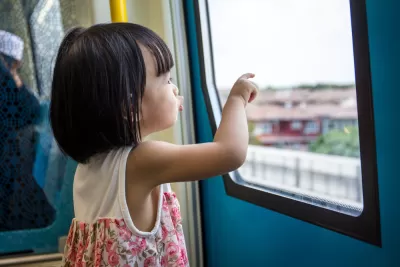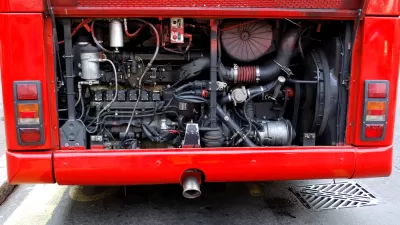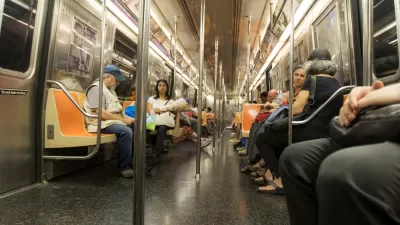Michael Smart and Nicholas Klein guest blog about their recent article in the Journal of Planning Education and Research.

Imagine a thirty-something born and bred New Yorker who packs up and move to Los Angeles. As a stereotypical New Yorker, she used transit or walked most places. Now that she lives in L.A., does her experience of using public transit in New York continue to influence her daily travel? Is she more likely to use transit than her Angeleno peers who have lived their whole lives in auto-dependent neighborhoods? Or does she adapt to the new reality, abandoning her transit habits in the context of a new built environment? In a recent publication in the Journal of Planning Education and Research (JPER), we test whether past experience living in areas with high-quality public transit influences travel behavior later in life.
We find that past experiences do shape future travel behavior. Our findings suggest that the quality of transit service in our neighborhoods constantly shapes future travel patterns, though there are eras when exposure to transit is most consequential. In particular, exposure to high-quality transit in our 20s or 30s increases the chances of using transit and decreases car ownership later in life, even if we move to a relatively transit-poor location. Where a person grows up also has a strong effect, suggesting that habits and preferences for transit may be formed at an early age. Most surprisingly, we find that when it comes to transit use today, the quality of transit experienced earlier in life can be just as important as the quality of transit in the current neighborhood.
In our study, we draw on a panel survey that has been following the same families and their offspring since 1968. This survey, the Panel Study of Income Dynamics, enables us to construct residential histories for everyone in the survey. Using three different data sets on transit service (Census journey-to-work data, the University of Minnesota Accessibility Observatory, and the Brookings transit access to jobs database), we can construct a history of each individual’s exposure to transit throughout their life. We then examine how "exposure" to different levels of transit service at different points in one's life is associated with more or less transit use and car ownership later in life.
For planners, these questions are not solely of academic interest. If exposure to transit at a young age encourages later transit use, there are implications for transportation policy and planning. Planners should consider transit as a long-term investment in neighborhoods and the people who live there. By encouraging exposure to transit at an early age (for instance, through free or reduced transit passes for students, recent transplants, or new hires), transit agencies and advocates could "plant the seed" for future ridership. These long-term benefits may be difficult to quantify and incorporate in cost-benefit analyses, though our research suggests the payoffs may be substantial.
Our research also suggests something about the effects of demographic change on transit use. Others have noted that young people are increasingly living in cities, though those trends may reverse as economic conditions improve and greater numbers of the Millennial generation begin to raise families. However, our analysis suggests that where someone lives during their 20s and 30s is particularly consequential for future travel behavior. Even if many of the younger cohort do move out to the suburbs, our work suggests that they will take some of their habits with them. Advocates should tap the latent support of young people by encouraging early exposure to public transportation. The payoffs may be substantial.
Open Access Until April 8, 2017

Planetizen Federal Action Tracker
A weekly monitor of how Trump’s orders and actions are impacting planners and planning in America.

San Francisco's School District Spent $105M To Build Affordable Housing for Teachers — And That's Just the Beginning
SFUSD joins a growing list of school districts using their land holdings to address housing affordability challenges faced by their own employees.

The Tiny, Adorable $7,000 Car Turning Japan Onto EVs
The single seat Mibot charges from a regular plug as quickly as an iPad, and is about half the price of an average EV.

Seattle's Plan for Adopting Driverless Cars
Equity, safety, accessibility and affordability are front of mind as the city prepares for robotaxis and other autonomous vehicles.

As Trump Phases Out FEMA, Is It Time to Flee the Floodplains?
With less federal funding available for disaster relief efforts, the need to relocate at-risk communities is more urgent than ever.

With Protected Lanes, 460% More People Commute by Bike
For those needing more ammo, more data proving what we already knew is here.
Urban Design for Planners 1: Software Tools
This six-course series explores essential urban design concepts using open source software and equips planners with the tools they need to participate fully in the urban design process.
Planning for Universal Design
Learn the tools for implementing Universal Design in planning regulations.
Smith Gee Studio
City of Charlotte
City of Camden Redevelopment Agency
City of Astoria
Transportation Research & Education Center (TREC) at Portland State University
US High Speed Rail Association
City of Camden Redevelopment Agency
Municipality of Princeton (NJ)






























